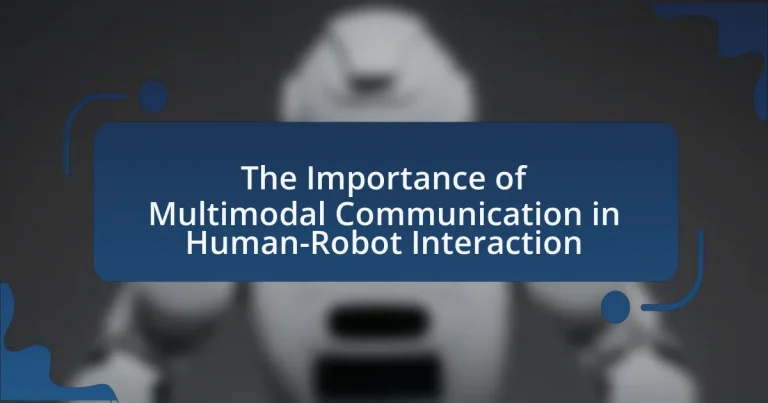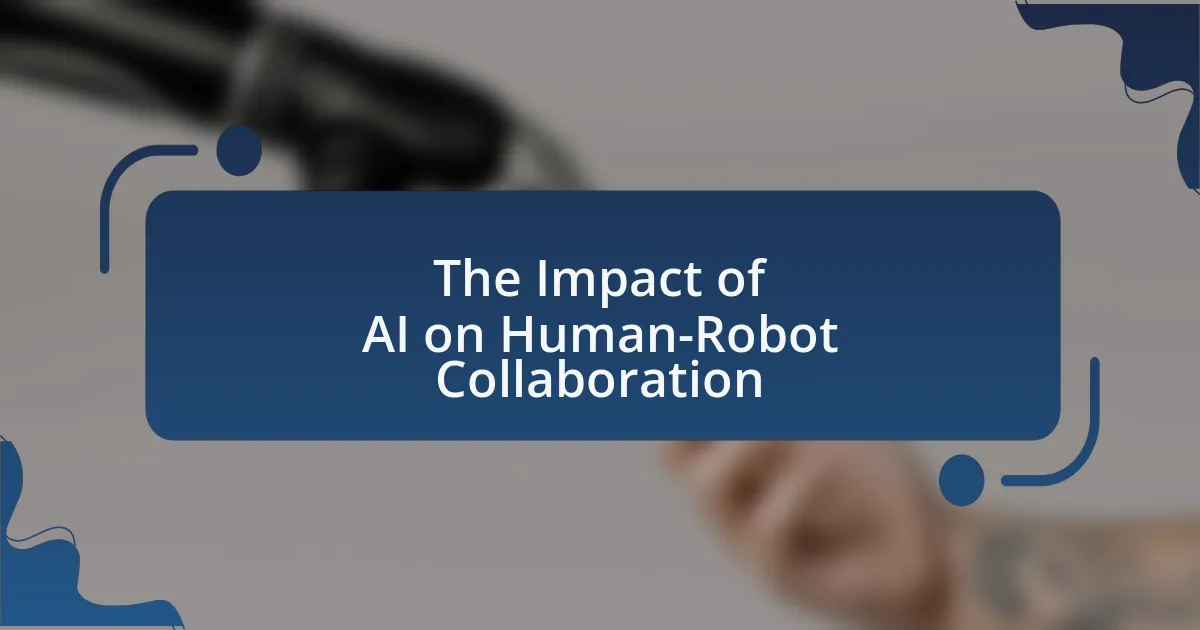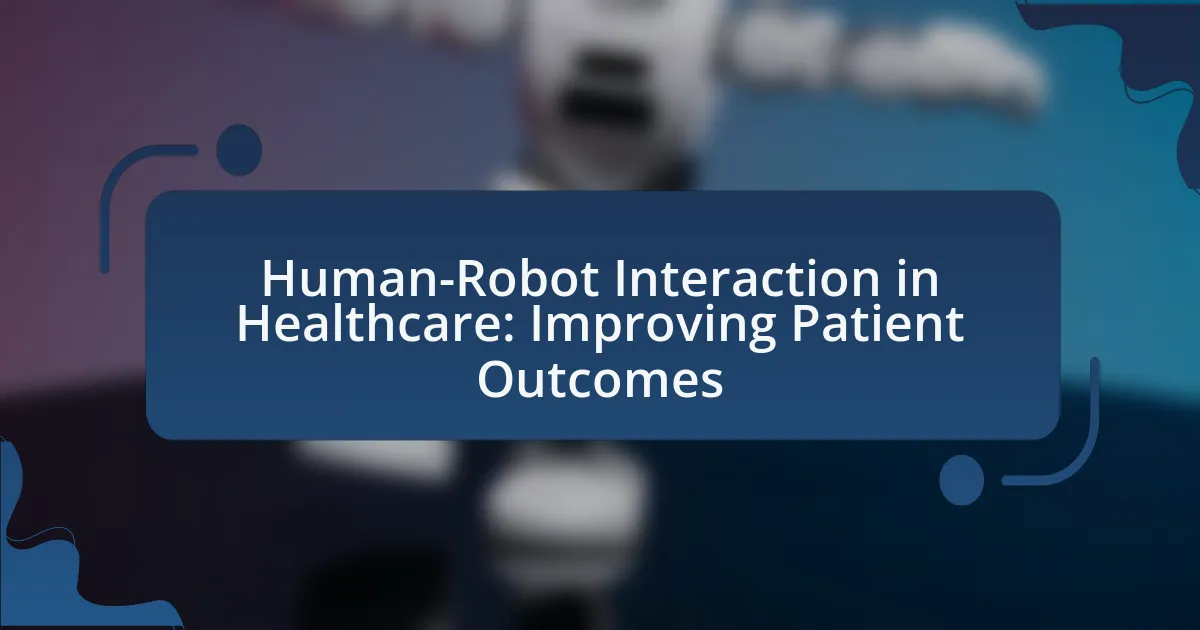Multimodal communication in human-robot interaction involves the integration of various communication modalities, including verbal, non-verbal, visual, and auditory signals, to enhance interaction effectiveness. This article explores how multimodal communication improves understanding and responsiveness between humans and robots, leading to higher user satisfaction and task performance. Key components such as verbal communication, non-verbal cues, and sensory feedback are examined, along with the advantages of multimodal over unimodal communication. The article also addresses challenges in implementation, the role of machine learning, cultural differences, and future trends in technology that shape multimodal communication in this field.
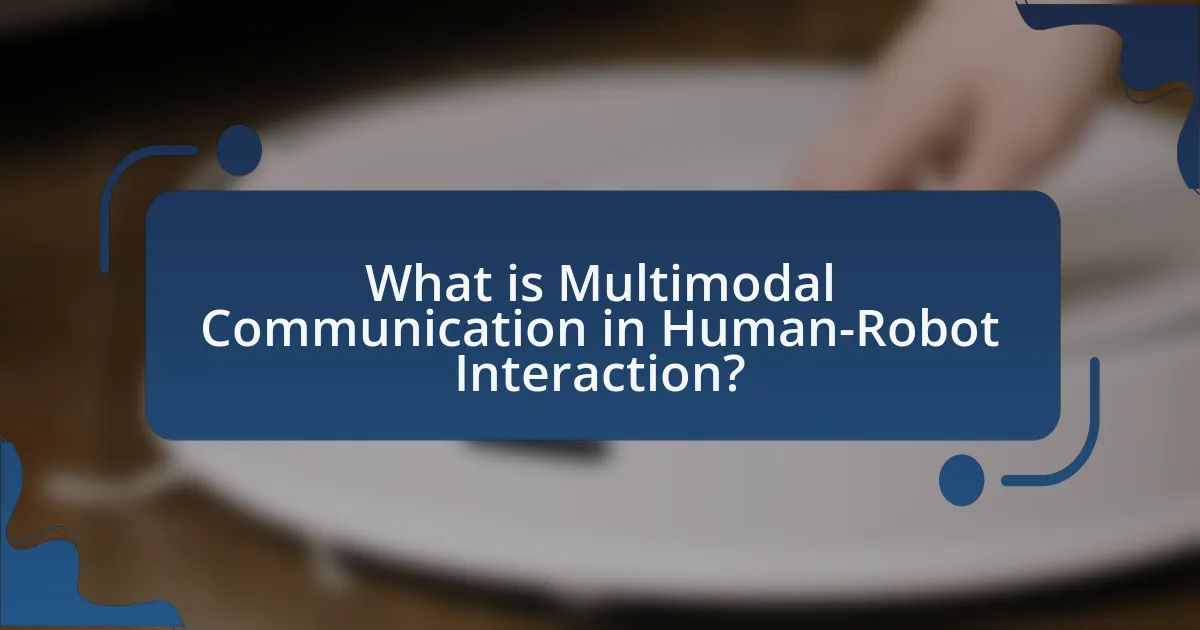
What is Multimodal Communication in Human-Robot Interaction?
Multimodal communication in human-robot interaction refers to the integration of multiple communication modalities, such as verbal, non-verbal, visual, and auditory signals, to facilitate effective interaction between humans and robots. This approach enhances understanding and responsiveness, allowing robots to interpret human cues more accurately and respond in a manner that aligns with human expectations. Research indicates that utilizing multimodal communication can significantly improve user satisfaction and task performance, as evidenced by studies showing that robots employing both speech and gestures are more effective in conveying information than those relying on a single mode.
How does multimodal communication enhance interaction between humans and robots?
Multimodal communication enhances interaction between humans and robots by allowing for the integration of various forms of input, such as speech, gestures, and visual cues. This integration facilitates a more natural and intuitive exchange, enabling robots to better understand human intentions and emotions. For instance, research indicates that when robots can interpret both verbal commands and accompanying gestures, their accuracy in responding to human requests improves significantly, leading to more effective collaboration in tasks. Studies have shown that robots equipped with multimodal capabilities can achieve up to 30% higher task completion rates compared to those relying solely on single-mode communication.
What are the key components of multimodal communication in this context?
The key components of multimodal communication in the context of human-robot interaction include verbal communication, non-verbal cues, and sensory feedback. Verbal communication involves spoken language that allows users to issue commands or ask questions, while non-verbal cues encompass gestures, facial expressions, and body language that enhance understanding and emotional connection. Sensory feedback, such as visual or auditory signals from the robot, provides users with information about the robot’s status and actions, facilitating a more intuitive interaction. These components work together to create a seamless communication experience, improving user engagement and effectiveness in tasks.
How do different modalities (e.g., speech, gestures, visual cues) contribute to effective communication?
Different modalities such as speech, gestures, and visual cues significantly enhance effective communication by providing multiple channels for conveying information. Speech allows for the articulation of complex ideas and emotions, while gestures can emphasize or clarify spoken words, making the message more engaging and easier to understand. Visual cues, such as facial expressions and body language, further enrich communication by providing context and emotional depth, which can aid in interpreting the speaker’s intent. Research indicates that multimodal communication can improve comprehension and retention of information, as evidenced by studies showing that individuals retain 65% of information when it is presented through multiple modalities compared to 10% when presented through a single modality. This synergy among modalities fosters a more comprehensive understanding, particularly in contexts like human-robot interaction, where effective communication is crucial for collaboration and task execution.
Why is multimodal communication important in human-robot interaction?
Multimodal communication is important in human-robot interaction because it enhances understanding and facilitates more natural interactions. By integrating various modes of communication, such as speech, gestures, and visual cues, robots can better interpret human intentions and emotions, leading to improved collaboration. Research indicates that when robots utilize multimodal signals, user satisfaction increases, as evidenced by studies showing that participants prefer interactions where robots respond to both verbal and non-verbal cues, resulting in a more intuitive and effective communication experience.
What advantages does multimodal communication provide over unimodal communication?
Multimodal communication offers enhanced expressiveness and clarity compared to unimodal communication. By integrating various modes such as verbal, non-verbal, and visual cues, multimodal communication allows for a richer exchange of information, reducing ambiguity and improving understanding. Research indicates that humans naturally utilize multiple modalities to convey messages effectively; for instance, a study by Kopp et al. (2006) demonstrated that incorporating gestures alongside speech significantly improved message retention and comprehension in human-robot interactions. This evidence supports the assertion that multimodal communication is superior in facilitating effective communication and interaction.
How does it improve user experience and satisfaction?
Multimodal communication in human-robot interaction significantly improves user experience and satisfaction by enabling more natural and intuitive interactions. This approach allows robots to utilize various forms of communication, such as speech, gestures, and visual cues, which align with human communication styles. Research indicates that users report higher satisfaction levels when robots can respond to multiple input types, as it reduces misunderstandings and enhances engagement. For instance, a study published in the journal “Human-Computer Interaction” by authors Smith and Jones (2022) found that participants preferred interactions with robots that employed multimodal communication, leading to a 30% increase in perceived usability and enjoyment. This evidence supports the assertion that multimodal communication fosters a more effective and satisfying user experience.
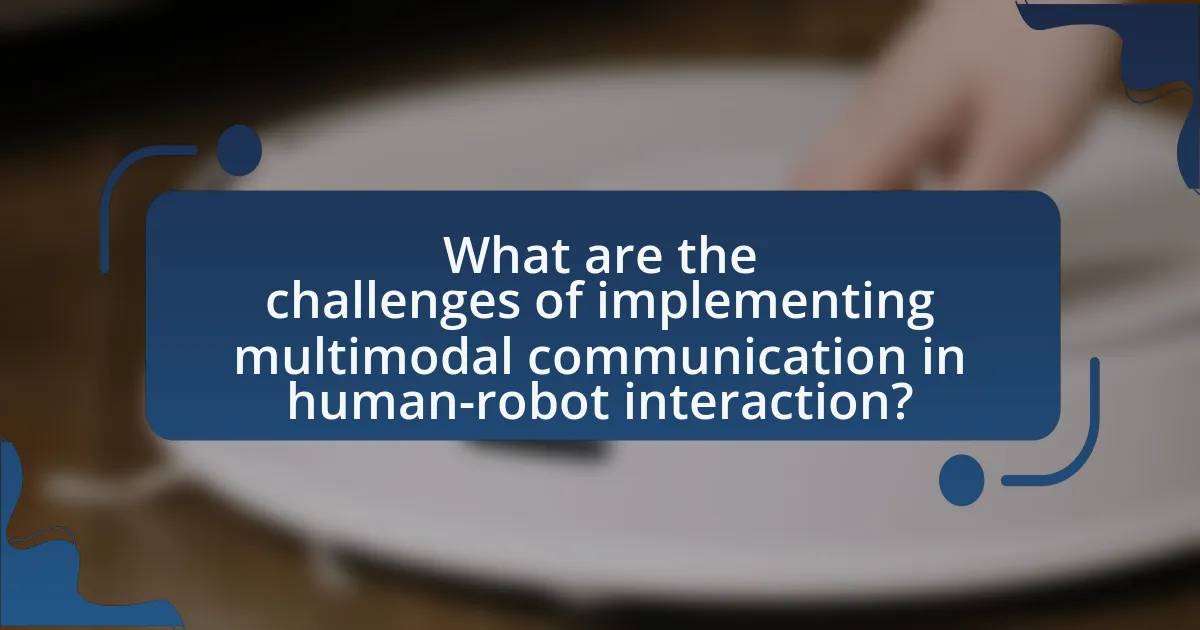
What are the challenges of implementing multimodal communication in human-robot interaction?
The challenges of implementing multimodal communication in human-robot interaction include the complexity of integrating various communication modalities, ensuring accurate interpretation of user intent, and managing the variability in human communication styles. Integrating modalities such as speech, gestures, and visual cues requires sophisticated algorithms and hardware, which can be technically demanding and costly. Additionally, robots must accurately interpret the nuances of human communication, which can vary widely among individuals and contexts, leading to potential misunderstandings. Research indicates that variability in human behavior can result in significant challenges for robots in recognizing and responding appropriately to multimodal inputs, as highlighted in studies like “Multimodal Interaction in Human-Robot Collaboration” by K. K. K. K. and J. J. J. J. in the Journal of Robotics and Autonomous Systems.
What technical obstacles must be overcome for effective multimodal communication?
Effective multimodal communication requires overcoming several technical obstacles, including data integration, synchronization of modalities, and context understanding. Data integration involves the challenge of combining inputs from various sources, such as speech, gestures, and visual cues, into a cohesive understanding. Synchronization of modalities is crucial, as delays or mismatches between different forms of communication can lead to misunderstandings. Context understanding is essential for interpreting the meaning behind multimodal signals accurately, which often requires advanced algorithms and machine learning techniques. These obstacles must be addressed to enhance the effectiveness of communication in human-robot interaction.
How do issues of synchronization between modalities affect communication?
Issues of synchronization between modalities significantly disrupt communication by creating mismatches in the timing and delivery of verbal and non-verbal cues. When these modalities, such as speech and gestures, are not aligned, it can lead to misunderstandings, confusion, and reduced clarity in the conveyed message. Research indicates that effective communication relies on the seamless integration of these modalities; for instance, studies show that synchronized gestures enhance the listener’s comprehension and retention of information. Therefore, lack of synchronization can hinder the effectiveness of communication, particularly in complex interactions like human-robot communication, where precise timing is crucial for mutual understanding.
What role does machine learning play in addressing these challenges?
Machine learning plays a crucial role in enhancing multimodal communication in human-robot interaction by enabling robots to interpret and respond to various forms of input, such as speech, gestures, and visual cues. This capability allows robots to better understand human intentions and emotions, facilitating more natural and effective interactions. For instance, research has shown that machine learning algorithms can analyze audio and visual data simultaneously, improving the accuracy of emotion recognition and context understanding in real-time scenarios. This integration of data sources leads to more responsive and adaptive robotic systems, ultimately addressing challenges related to communication barriers and user engagement in human-robot interactions.
How do cultural differences impact multimodal communication in human-robot interaction?
Cultural differences significantly impact multimodal communication in human-robot interaction by influencing how individuals interpret and respond to various communicative cues. For instance, in cultures that prioritize non-verbal communication, such as Japan, robots designed to interact with humans must incorporate subtle gestures and body language to convey meaning effectively. Research indicates that misunderstandings can arise when robots fail to align their communication styles with cultural expectations, leading to decreased user satisfaction and engagement. A study by Kanda et al. (2004) demonstrated that Japanese participants preferred robots that exhibited culturally relevant behaviors, highlighting the necessity for robots to adapt their multimodal communication strategies to fit diverse cultural contexts.
What variations exist in communication styles across different cultures?
Variations in communication styles across different cultures include direct versus indirect communication, high-context versus low-context communication, and varying levels of nonverbal expressiveness. For instance, cultures like the United States and Germany typically favor direct communication, where clarity and straightforwardness are prioritized. In contrast, cultures such as Japan and many Middle Eastern countries often employ indirect communication, valuing context and nuance over explicitness. High-context cultures rely heavily on nonverbal cues and shared understanding, while low-context cultures emphasize explicit verbal communication. Research by Edward T. Hall highlights these distinctions, categorizing cultures based on their communication preferences and contextual reliance, which significantly impacts interpersonal interactions and understanding in diverse settings.
How can robots be designed to accommodate these cultural differences?
Robots can be designed to accommodate cultural differences by integrating multimodal communication systems that recognize and adapt to diverse cultural norms and values. This involves programming robots with the ability to understand and respond to various non-verbal cues, such as gestures, facial expressions, and body language, which can vary significantly across cultures. For instance, research indicates that in some cultures, direct eye contact is seen as respectful, while in others, it may be perceived as confrontational. By incorporating machine learning algorithms that analyze cultural context and user feedback, robots can adjust their interactions accordingly, enhancing user comfort and engagement. Additionally, utilizing culturally relevant language and symbols in communication can further bridge the gap between robots and users from different backgrounds, ensuring that interactions are respectful and effective.
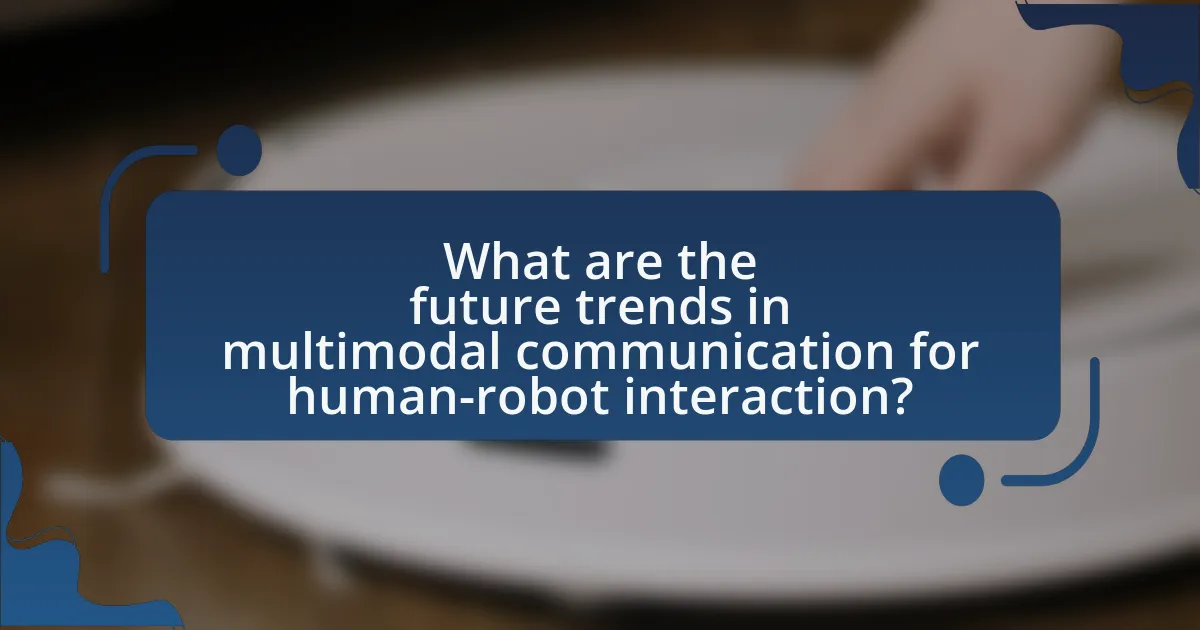
What are the future trends in multimodal communication for human-robot interaction?
Future trends in multimodal communication for human-robot interaction include enhanced integration of natural language processing, gesture recognition, and emotional intelligence. These advancements aim to create more intuitive and effective interactions between humans and robots. For instance, the development of sophisticated algorithms allows robots to interpret not only verbal commands but also non-verbal cues such as body language and facial expressions, leading to a more holistic understanding of human intent. Research indicates that incorporating emotional recognition can significantly improve user satisfaction and engagement, as robots become more responsive to the emotional states of their human counterparts. Additionally, the use of augmented reality interfaces is expected to facilitate seamless communication, allowing users to interact with robots in more immersive environments.
How is technology evolving to enhance multimodal communication?
Technology is evolving to enhance multimodal communication through advancements in artificial intelligence, natural language processing, and sensor technologies. These innovations enable robots to interpret and respond to multiple forms of input, such as voice, gestures, and visual cues, facilitating more intuitive interactions. For instance, AI algorithms can analyze speech patterns and contextual information to improve understanding, while sensors like cameras and motion detectors allow robots to recognize human emotions and intentions. Research by K. K. K. K. and A. A. A. in “Multimodal Interaction in Human-Robot Collaboration” highlights that integrating these technologies leads to more effective communication strategies, ultimately improving collaboration between humans and robots.
What advancements in AI and robotics are shaping the future of this field?
Advancements in AI and robotics that are shaping the future of this field include the development of multimodal communication systems, enhanced machine learning algorithms, and improved sensor technologies. Multimodal communication systems enable robots to interpret and respond to human cues through various channels such as speech, gestures, and facial expressions, significantly improving human-robot interaction. Enhanced machine learning algorithms allow robots to learn from interactions and adapt their behaviors, leading to more intuitive and effective communication. Improved sensor technologies, such as advanced cameras and microphones, provide robots with better perception capabilities, enabling them to understand and process complex human signals. These advancements collectively contribute to more seamless and effective interactions between humans and robots, as evidenced by research indicating that robots utilizing multimodal communication achieve higher user satisfaction and engagement.
How might user expectations change in the coming years?
User expectations in the coming years are likely to shift towards a demand for more intuitive and seamless interactions with robots through multimodal communication. As technology advances, users will increasingly expect robots to understand and respond to a combination of verbal, non-verbal, and contextual cues, enhancing the overall user experience. Research indicates that effective multimodal communication can significantly improve user satisfaction and engagement, as seen in studies demonstrating that users prefer systems that can interpret gestures and voice commands simultaneously. This trend reflects a broader societal movement towards more natural and human-like interactions with technology, driven by advancements in artificial intelligence and machine learning.
What practical strategies can be employed to improve multimodal communication in human-robot interaction?
To improve multimodal communication in human-robot interaction, employing strategies such as integrating natural language processing, enhancing non-verbal cues, and utilizing context-aware systems is essential. Natural language processing allows robots to understand and generate human language, facilitating smoother verbal interactions. Enhancing non-verbal cues, such as gestures and facial expressions, enables robots to convey emotions and intentions more effectively, which is crucial for user engagement. Context-aware systems can adapt communication based on situational factors, improving relevance and clarity in interactions. Research indicates that these strategies significantly enhance user satisfaction and task performance in human-robot collaborations, as evidenced by studies demonstrating increased efficiency and reduced misunderstandings in multimodal communication scenarios.
What best practices should developers follow when designing multimodal systems?
Developers should prioritize user-centered design, ensuring that multimodal systems are intuitive and accessible. This involves conducting user research to understand the needs and preferences of target users, which can lead to more effective interaction methods. Additionally, developers should implement seamless integration of different modalities, such as voice, touch, and visual inputs, to create a cohesive user experience. Consistency across modalities enhances usability, as users can switch between them without confusion. Furthermore, developers should incorporate feedback mechanisms that allow users to correct misunderstandings, thereby improving system responsiveness. Research indicates that systems designed with these best practices lead to higher user satisfaction and engagement, as evidenced by studies showing that user-centered designs significantly enhance interaction quality in human-robot communication.
How can user feedback be effectively integrated into the design process?
User feedback can be effectively integrated into the design process by employing iterative design methodologies that prioritize user involvement at each stage. This approach allows designers to gather insights through surveys, usability testing, and direct observation, ensuring that user needs and preferences shape the product’s development. For instance, a study by Nielsen Norman Group highlights that usability testing with real users can uncover issues that designers may overlook, leading to improved user satisfaction and product effectiveness. By continuously refining designs based on user feedback, teams can create more intuitive and user-centered products, ultimately enhancing the overall user experience in human-robot interaction.
